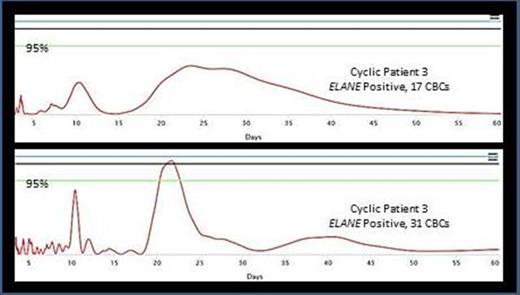Abstract

Background: Cyclic neutropenia is characterized by oscillatory fluctuations in blood neutrophil counts, usually with nadirs <0.2 x 109/L at approximately 3 week intervals. Visual inspection of graphs of serial counts is usually the basis for diagnosis. Detection of mutations in ELANE is helpful but not diagnostic because of the overlap of the specific mutation patterns with those associated with severe congenital neutropenia. Making the correct diagnosis of cyclic neutropenia is important because these patients are not thought to be at risk of developing myelodysplasia or acute myeloid leukemia (MDS/AML). In contrast, patients with severe congenital neutropenia, whose counts are usually lower, are at risk of developing MDS/AML.
Methods: We have implemented a website application for easy and direct data entry of serial blood counts to detect statistically significant periodicities using the Lomb periodogram. Physicians, nurses, other healthcare providers or patients can directly enter the blood count data for analysis on a website to allow immediate visualization of the serial counts and calculation of the probability of statistically significant cycling and the period, i.e., length of the cycle.
Results: We have analyzed the counts from 42 patients (21 ELANE positive, 8 ELANE negative, 13 ELANE unknown) enrolled in the Severe Chronic Neutropenia International Registry with a clinical diagnosis of cyclic neutropenia to determine the accuracy of clinical diagnoses based on this form of statistical analysis.
Our preliminary results showed that it is easy to learn how to use this program. We estimate that at least 20 counts obtained at 2-3 day intervals for 6 weeks are the minimum needed to detect cyclic neutropenia on a statistically sound basis, while 20-40 counts obtained at 2-3 day intervals over an 8-10 week period was more likely to yield statistical and clinical certainty about the diagnosis. The figure below shows readouts for the periodogram analysis for one patient. It shows the influence of 17 counts versus 31 counts for a patient with the clinical diagnosis of cyclic neutropenia and a mutation in ELANE. The confidence intervals (95%) and (99%) are exceeded for the series of 31 counts but not for the shorter series. The peak, approximate cycle length is 22 days for this series of counts.
As of yet, we do not have the sufficient daily count data to determine if more frequent testing (e.g. daily testing) is better than testing every 2-3 days. We are currently testing the patterns of neutrophil fluctuations in patients on G-CSF to see if cyclic neutropenia can be diagnosed in patients that are on (or during) treatment. We have learned that many patients with the clinical diagnosis of CyN do not have sufficient serial blood cell count data to confirm this diagnosis on a statistical basis.
Conclusion: We have developed a simple method for making periodogram analysis much more widely available to clinicians and patients on a world-wide basis. Statistical analysis of carefully collected serial data will help to secure the diagnosis of cyclic neutropenia and provide patients with important prognostic information.
Dale:Amgen: Consultancy, Honoraria, Research Funding.
Author notes
Asterisk with author names denotes non-ASH members.

This icon denotes a clinically relevant abstract


This feature is available to Subscribers Only
Sign In or Create an Account Close Modal